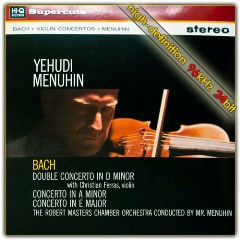J.S. Bach – Violin Concertos (Menuhin)
Bach – Violin Concertos (Menuhin)

1. Violin Concerto No.1 in A minor: BWV.1041: Allegro 2. Violin Concerto No.1 in A minor: Andante 3. Violin Concerto No.1 in A minor: Allegro assai 4. Concerto for 2 Violins in D minor BMW 1043: Vivace 5. Concerto for 2 Violins in D minor: Largo ma non tanto 6. Concerto for 2 Violins in D minor: Allegro 7. Violin Concerto No. 2 in E, Bmw.1042: Allegro 8. Violin Concerto No. 2 in E, Bmw.1042: Adagio 9. Violin Concerto No. 2 in E, Bmw.1042: Allegro assai Yehudi Menuhin – violin, conductor Christian Ferras – violin Robert Masters Chamber Orchestra
The music of Bach was central to Yehudi Menuhin’s universe from the day of the very first lesson he received from Louis Persinger in San Francisco. Having disposed of the teaching part of the lesson fairly quickly, Persinger sat the five-year-old prodigy and his mother down and played them the Adagio from Bach’s solo Sonata in G minor. It was his way of setting the standard at which Yehudi must aim, one that he remembered for the rest of his long life. When Yehudi was seven and the time came to learn a concerto, it was the Bach Concerto in E major that Persinger chose for him. Later Yehudi studied with two of the finest Bach players of the twentieth century, Adolf Busch and George Enescu; and so the purity of Bach’s thinking, the spiritual ecstasy of his slower movements and the vigour of his faster rhythms were constant factors in the boy’s musical upbringing. In the late 1950s and early 1960s Menuhin was to set down an epoch-making series of recordings of Bach’s music; and the Double Concerto in particular played an important rôle in his life. He would use it as a way of sealing a friendship with a fellow violinist or giving encouragement to a younger colleague, just as his own teacher George Enescu had encouraged him by playing the concerto with him in the early 1930s. Menuhin left countless live recordings of the work and played it in the studio with Gioconda de Vito and Christian Ferras, among others. His last recording as a violinist, made in 1992, was a performance of the Double Concerto with his pupil Alberto Lysy as partner. The version with Enescu reproduced here was made six decades earlier.
The idea of recording Yehudi Menuhin in the Double Concerto with his teacher came from the Moshe Menuhin, who always had an eye towards publicity for his son. Early in September 1930 he wrote to Yehudi’s English record company, His Master’s Voice, to suggest a collaboration in this work with Adolf Busch, with whom Yehudi had been studying in Basel since the summer of 1929. Fred Gaisberg passed on the suggestion to Busch, who was also on the HMV roster of artists, and suggested a session in May 1931, writing that the concerto should be a big sales proposition, but the great violinist felt it was too early for the boy to record this work and gently pointed out that he always put artistic considerations before commercial ones. George Enescu, to whom Yehudi returned in 1931, proved more accommodating to what Gaisberg freely admitted was a publicity stunt. Having given a concert performance of the concerto together in Paris in December 1931, with Pierre Monteux conducting the Paris Symphony Orchestra, Enescu and Yehudi made their famous recording in that city on 4th June 1932, with the same orchestra and conductor. The interpretation still sounds excellent today, in spite of an over-large orchestra, because Monteux keeps everything in trim and Enescu’s personality can be felt in every bar. It is sad to reflect that this was the last solo recording made by the Romanian violinist while he was still in his prime. The Violin Concertos in E major and A minor, recorded in 1933 and 1936 respectively, sound less convincing now, partly because Enescu is not in the class of Monteux as a conductor; the rhythms plod and the tempi in the two finales are too slow. Menuhin was to make infinitely better recordings of both works in 1958. These early efforts, however, are of interest as staging points in the progress of a great musician, and his playing, in itself, is often beautiful. --- classicsonline.com
Last Updated (Monday, 12 March 2012 15:37)








